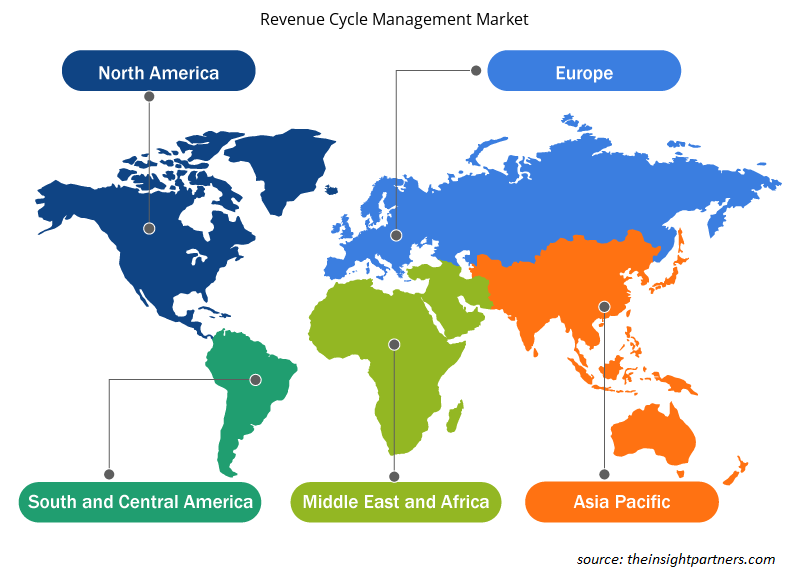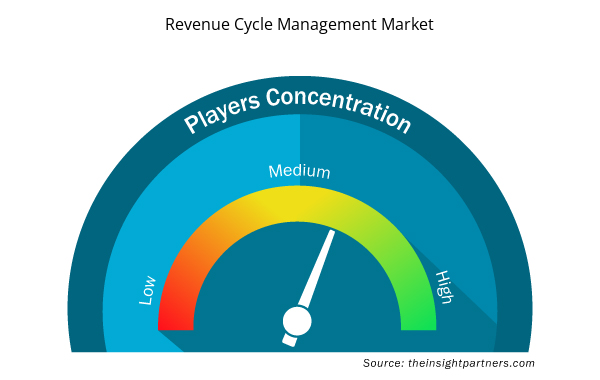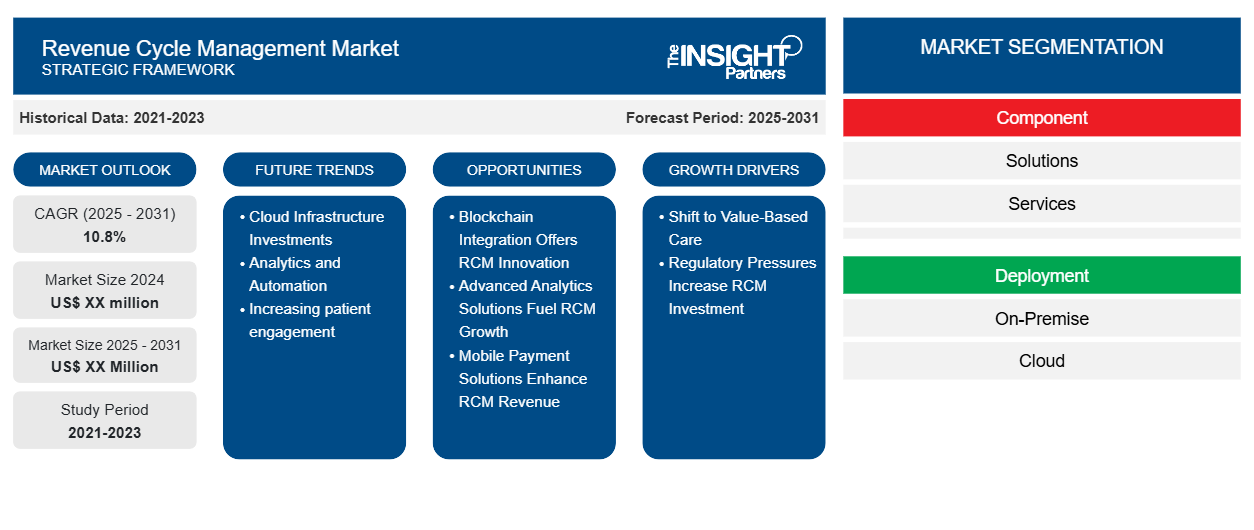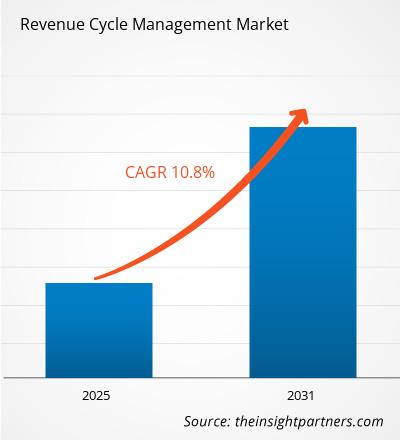[研究报告] 收入周期管理市场预计将从 2022 年的 983.4 亿美元增长到 2031 年的 2446.4 亿美元;预计 2022 年至 2031 年的复合年增长率为 12.1%。CAGR of 12.1% from 2022 to 2031.
分析师观点:
政府鼓励使用收入周期管理解决方案的举措增多是推动收入周期管理市场增长的主要因素之一。此外,医疗机构计费错误和流程改进导致的收入损失增加,这也推动了收入周期管理市场的增长。正确处理医疗索赔对医疗保健提供者的收入来源至关重要。医疗机构必须继续保持高质量的保险计费和收入周期,以改善其财务业绩。大多数医疗保健提供者因索赔被拒以及未能提交或推迟被拒索赔而蒙受损失,这给医院带来了越来越大的削减开支的压力。这为市场参与者创造了一个机会,让他们为医院提出先进的解决方案,以应对上述收入周期挑战。此外,为了有效管理收入周期,市场上的各个主要参与者正在整合人工智能 (AI) 和机器学习 (ML) 技术,这将进一步推动收入周期管理市场的增长。
市场概况:
医疗机构利用收入周期管理 (RCM),这是一种使用医疗账单软件跟踪患者护理事件(从注册和预约安排到最后支付余额)的财务流程。为了存储和管理患者账单记录,医疗服务提供商经常投资收入周期管理系统。当患者完成治疗过程时,高效的 RCM 系统可以与其他医疗 IT 系统(如电子健康记录 (EHR)和医疗账单系统)连接,以缩短提供服务和获得付款之间的时间。医疗保健公司还可以通过自动执行员工以前在 RCM 系统的帮助下执行的任务来节省时间。管理任务包括通知患者即将到来的预约、提醒付款人和患者未结余额,以及在索赔被拒绝时联系保险公司进行具体询问。RCM 系统还可以通过向提供商提供有关拒绝索赔原因的信息来帮助提供商节省资金。这让提供商更好地了解某些索赔被拒绝的原因,使他们能够解决问题并避免他们不得不重新提交索赔。RCM), a financial process that tracks patient care episodes from registration and appointment scheduling to the last payment of a balance, using medical billing software. To store and manage patient billing records, healthcare providers frequently invest in revenue cycle management systems. When a patient progresses through the treatment process, an efficient RCM system can connect with other health IT systems, such as EHR)RCM system. Administrative tasks include notifying patients of forthcoming appointments, reminding payers and patients of outstanding balances, and contacting insurers with specific inquiries if a claim is rejected. RCM systems can also help providers save money by providing them with information about the reasons behind refused claims. This gives providers better insight into why some claims have been refused, allowing them to address the matter and preventing them from having to resubmit the claim.
定制此报告以满足您的需求
您可以免费定制任何报告,包括本报告的部分内容、国家级分析、Excel 数据包,以及为初创企业和大学提供优惠和折扣
- 获取此报告的关键市场趋势。这个免费样品将包括数据分析,从市场趋势到估计和预测。
市场驱动因素:
人工智能和机器学习技术的融合为收入周期管理市场的增长创造了机会
AI 和 ML 技术继续获得发展势头,并在收入管理系统开发中证明其潜力。许多组织仍然依赖手动错误检查和报告进行异常检测,这使得很难确定根本原因,并且成为一个耗时的过程。ML 和 AI 可帮助组织主动识别计费和收入管理解决方案中的异常模式。此外,由于定期更新,该模型会随着时间的推移不断改进,从而实现准确计费和自动检测异常。AI 和 ML 还可以加速根本原因分析,减少调查时间和成本,并使用收入管理系统提供更快的解决方案。因此,计费和收入管理领域的技术进步日新月异,可能会在预测期内推动收入周期管理市场的增长。
节段分析:
根据组件,收入周期管理市场细分为解决方案和服务。解决方案部分在 2022 年占据了收入周期管理市场的最大份额,而服务部分预计在预测期内在收入周期管理市场中实现最高复合年增长率。RCM 软件在医疗保健行业的采用率正在上升,尤其是在避免医疗保健欺诈和降低管理成本方面。此外,市场上的各个主要参与者都在不断致力于提供先进的解决方案,以改善医院、医疗机构和其他机构的收入周期管理。此外,由于对基于云的 RCM 的需求增加以及对专业服务的需求增加,预计服务部分将以收入周期管理市场中最高的复合年增长率增长。
区域分析:
北美的医疗保健行业正在迅速变化,数字化使安装医疗 IT 服务(如收入周期管理 (RCM) 系统)变得更加容易,该系统使用同步管理软件解决方案来组织和简化医疗保健业务中的活动。此外,医疗保健行业越来越关注加强患者护理,同时利用该地区各市场参与者提供的这些尖端创新 RCM 解决方案的财务优势和有效性,这推动了市场的增长。此外,由于多种因素,美国的医疗保健行业正在迅速扩张和变化,包括医疗成本上升、知名医疗机构数量增加、医疗 IT 支出增加、医疗 IT 基础设施改善以及对患者与提供者关系的日益重视。根据美国医疗保险和医疗补助服务中心的数据,2021 年国民医疗支出 (NHE) 增长 2.7%,达到 4.3 万亿美元(人均 12,914 美元),占 GDP 的 18.3%。此外,2021 年医疗保险支出增长 8.4% 至 9008 亿美元,占 NHE 总额的 21%。2021 年医疗补助支出增长 9.2% 至 7340 亿美元,占 NHE 总额的 17%。随着美国医疗保健支出的大幅增加,医疗服务提供商在计费和精确付款方面面临着复杂的挑战,这进一步增加了对更先进的 RCM 系统的需求。
此外,该地区的各种市场参与者都在不断努力提供先进的解决方案。例如,2023 年,医疗财务管理协会 (HFMA) 宣布与医疗收入周期管理软件即服务 (SaaS) 提供商 FinThrive, Inc. 建立战略联盟,共同推出同行评审的五阶段收入周期管理技术采用模型 (RCMTAM),旨在帮助医疗系统利用行业基准来评估其当前的 RCM 技术成熟度状态并制定最佳实践计划以优化收入周期结果。因此,所有上述因素都在推动北美收入周期管理市场的增长。
关键球员分析:
Athenahealth Inc.、Experian Information Solutions Inc.、GE Healthcare、McKesson Corporation、NXGN Management LLC、Optum Inc.、Oracle Corporation、R1 RCM Inc.、The SSI Group 和 Veradigm LLC 是收入周期管理市场的主要参与者。这些收入周期管理市场参与者专注于持续的产品开发和创新。
最新动态:
收入周期管理市场中的公司大量采用并购等无机和有机策略。以下列出了一些最近的收入周期管理市场发展:
- 2023 年 10 月,Omega Healthcare 宣布推出其 Omega 数字平台 (ODP),旨在帮助医疗保健组织减轻管理负担,同时提高财务绩效。ODP 利用先进的专有技术来简化工作流程并提高财务绩效。它利用机器人流程自动化 (RPA)、AI 和 ML、机器人和自然语言处理 (NLP) 方面的深厚领域和技术专业知识,使解决方案能够提高效率和准确性。
- 2021 年 6 月,领先的运营管理和分析公司 EXL 宣布其 EXL Health 部门将推出新的综合收入管理解决方案。EXL Health 与 REVELOHEALTH 合作,后者是一家致力于将医疗保健数据转化为可操作信息的解决方案提供商。EXL Health 和 REVELOHEALTH 结合了他们的知识和专业知识,提供了新的解决方案,可提供全面的、数据驱动的支付处理和收入分析功能。这项新功能旨在帮助提供商优化收入周期管理、运营目标和合规性。
- 2021 年 6 月,领先的咨询和专业服务机构 Vee Technologies 宣布推出 Sona Suite 产品及其旗舰 RCM 工作流程工具 Sona PROMISE。RCM 解决方案旨在增强运营工作流程并实现商业智能功能,并且能够成为管理医院、专科诊所、医疗诊所、门诊手术中心等的独立工具。该解决方案旨在简化业务运营并提供高级业务分析,以增加收入和增长潜力。
- 2021 年 1 月,领先的医疗保健行业技术支持型收入周期管理 (RCM) 服务提供商 R1 RCM Inc 推出了一款新的医生收入周期管理解决方案 R1 Professional,适用于大型独立诊所和医院所属的医疗集团。新解决方案由专门构建的技术平台、大规模自动化、符合消费者期望的数字患者财务体验以及经过验证的性能改进功能提供支持,这些功能可增强大型医疗保健组织的财务可视性。
报告范围
收入周期管理市场区域洞察
Insight Partners 的分析师已详细解释了预测期内影响收入周期管理市场的区域趋势和因素。本节还讨论了北美、欧洲、亚太地区、中东和非洲以及南美和中美洲的收入周期管理市场细分和地理位置。

- 获取收入周期管理市场的区域特定数据
收入周期管理市场报告范围
| 报告属性 | 细节 |
|---|---|
| 2023 年的市场规模 | XX 百万美元 |
| 2031 年市场规模 | XX 百万美元 |
| 全球复合年增长率(2023 - 2031) | 10.8% |
| 史料 | 2021-2022 |
| 预测期 | 2024-2031 |
| 涵盖的领域 | 按组件
|
| 覆盖地区和国家 | 北美
|
| 市场领导者和主要公司简介 |
|
收入周期管理市场参与者密度:了解其对业务动态的影响
收入周期管理市场正在快速增长,这得益于最终用户需求的不断增长,而这些需求又源于消费者偏好的不断变化、技术进步以及对产品优势的认识不断提高等因素。随着需求的增加,企业正在扩大其产品范围,进行创新以满足消费者的需求,并利用新兴趋势,从而进一步推动市场增长。
市场参与者密度是指在特定市场或行业内运营的企业或公司的分布情况。它表明在给定市场空间中,相对于其规模或总市场价值,有多少竞争对手(市场参与者)存在。
在收入周期管理市场运营的主要公司有:
- Allscripts 医疗保健解决方案有限公司
- 雅典娜健康公司
- Cerner 公司
- Eclinicalworks有限责任公司
- Epic 系统公司
免责声明:上面列出的公司没有按照任何特定顺序排列。

- 获取收入周期管理市场顶级关键参与者概览
- 历史分析(2 年)、基准年、预测(7 年)及复合年增长率
- PEST 和 SWOT 分析
- 市场规模价值/数量 - 全球、区域、国家
- 行业和竞争格局
- Excel 数据集



Report Coverage
Revenue forecast, Company Analysis, Industry landscape, Growth factors, and Trends

Segment Covered
This text is related
to segments covered.

Regional Scope
North America, Europe, Asia Pacific, Middle East & Africa, South & Central America

Country Scope
This text is related
to country scope.
常见问题
Some of the customization options available based on request are additional 3-5 company profiles and country-specific analysis of 3-5 countries of your choice. Customizations are to be requested/discussed before making final order confirmation, as our team would review the same and check the feasibility.
The report can be delivered in PDF/PPT format; we can also share excel dataset based on the request.
Key companies in this market are: Allscripts Healthcare Solutions Inc, Athenahealth Inc, Cerner Corporation, Eclinicalworks LLC, Epic Systems Corporation, Experian PLC, GE Healthcare, Gebbs Healthcare Solutions, McKesson Corporation
The Revenue Cycle Management Market is expected to register a CAGR of 10.8% from 2023-2031.
Key future trends in this market are - Adoption of cloud-based solutions, Improved billing accuracy, Focus on cost reduction
The major factors impacting the Revenue Cycle Management Market are: Shift Towards Value-Based Care, Increasing Regulatory Compliance Requirements, and Adoption of Advanced Technologies
Trends and growth analysis reports related to Technology, Media and Telecommunications : READ MORE..
The List of Companies
1. Allscripts Healthcare Solutions, Inc.
2. Athenahealth, Inc.
3. Cerner Corporation
4. Eclinicalworks, LLC
5. Epic Systems Corporation
6. Experian PLC
7. GE Healthcare
8. Gebbs Healthcare Solutions
9. Mckesson Corporation
10. Quest Diagnostics Incorporated
The Insight Partners performs research in 4 major stages: Data Collection & Secondary Research, Primary Research, Data Analysis and Data Triangulation & Final Review.
- Data Collection and Secondary Research:
As a market research and consulting firm operating from a decade, we have published and advised several client across the globe. First step for any study will start with an assessment of currently available data and insights from existing reports. Further, historical and current market information is collected from Investor Presentations, Annual Reports, SEC Filings, etc., and other information related to company’s performance and market positioning are gathered from Paid Databases (Factiva, Hoovers, and Reuters) and various other publications available in public domain.
Several associations trade associates, technical forums, institutes, societies and organization are accessed to gain technical as well as market related insights through their publications such as research papers, blogs and press releases related to the studies are referred to get cues about the market. Further, white papers, journals, magazines, and other news articles published in last 3 years are scrutinized and analyzed to understand the current market trends.
- Primary Research:
The primarily interview analysis comprise of data obtained from industry participants interview and answers to survey questions gathered by in-house primary team.
For primary research, interviews are conducted with industry experts/CEOs/Marketing Managers/VPs/Subject Matter Experts from both demand and supply side to get a 360-degree view of the market. The primary team conducts several interviews based on the complexity of the markets to understand the various market trends and dynamics which makes research more credible and precise.
A typical research interview fulfils the following functions:
- Provides first-hand information on the market size, market trends, growth trends, competitive landscape, and outlook
- Validates and strengthens in-house secondary research findings
- Develops the analysis team’s expertise and market understanding
Primary research involves email interactions and telephone interviews for each market, category, segment, and sub-segment across geographies. The participants who typically take part in such a process include, but are not limited to:
- Industry participants: VPs, business development managers, market intelligence managers and national sales managers
- Outside experts: Valuation experts, research analysts and key opinion leaders specializing in the electronics and semiconductor industry.
Below is the breakup of our primary respondents by company, designation, and region:

Once we receive the confirmation from primary research sources or primary respondents, we finalize the base year market estimation and forecast the data as per the macroeconomic and microeconomic factors assessed during data collection.
- Data Analysis:
Once data is validated through both secondary as well as primary respondents, we finalize the market estimations by hypothesis formulation and factor analysis at regional and country level.
- Macro-Economic Factor Analysis:
We analyse macroeconomic indicators such the gross domestic product (GDP), increase in the demand for goods and services across industries, technological advancement, regional economic growth, governmental policies, the influence of COVID-19, PEST analysis, and other aspects. This analysis aids in setting benchmarks for various nations/regions and approximating market splits. Additionally, the general trend of the aforementioned components aid in determining the market's development possibilities.
- Country Level Data:
Various factors that are especially aligned to the country are taken into account to determine the market size for a certain area and country, including the presence of vendors, such as headquarters and offices, the country's GDP, demand patterns, and industry growth. To comprehend the market dynamics for the nation, a number of growth variables, inhibitors, application areas, and current market trends are researched. The aforementioned elements aid in determining the country's overall market's growth potential.
- Company Profile:
The “Table of Contents” is formulated by listing and analyzing more than 25 - 30 companies operating in the market ecosystem across geographies. However, we profile only 10 companies as a standard practice in our syndicate reports. These 10 companies comprise leading, emerging, and regional players. Nonetheless, our analysis is not restricted to the 10 listed companies, we also analyze other companies present in the market to develop a holistic view and understand the prevailing trends. The “Company Profiles” section in the report covers key facts, business description, products & services, financial information, SWOT analysis, and key developments. The financial information presented is extracted from the annual reports and official documents of the publicly listed companies. Upon collecting the information for the sections of respective companies, we verify them via various primary sources and then compile the data in respective company profiles. The company level information helps us in deriving the base number as well as in forecasting the market size.
- Developing Base Number:
Aggregation of sales statistics (2020-2022) and macro-economic factor, and other secondary and primary research insights are utilized to arrive at base number and related market shares for 2022. The data gaps are identified in this step and relevant market data is analyzed, collected from paid primary interviews or databases. On finalizing the base year market size, forecasts are developed on the basis of macro-economic, industry and market growth factors and company level analysis.
- Data Triangulation and Final Review:
The market findings and base year market size calculations are validated from supply as well as demand side. Demand side validations are based on macro-economic factor analysis and benchmarks for respective regions and countries. In case of supply side validations, revenues of major companies are estimated (in case not available) based on industry benchmark, approximate number of employees, product portfolio, and primary interviews revenues are gathered. Further revenue from target product/service segment is assessed to avoid overshooting of market statistics. In case of heavy deviations between supply and demand side values, all thes steps are repeated to achieve synchronization.
We follow an iterative model, wherein we share our research findings with Subject Matter Experts (SME’s) and Key Opinion Leaders (KOLs) until consensus view of the market is not formulated – this model negates any drastic deviation in the opinions of experts. Only validated and universally acceptable research findings are quoted in our reports.
We have important check points that we use to validate our research findings – which we call – data triangulation, where we validate the information, we generate from secondary sources with primary interviews and then we re-validate with our internal data bases and Subject matter experts. This comprehensive model enables us to deliver high quality, reliable data in shortest possible time.


 获取此报告的免费样本
获取此报告的免费样本